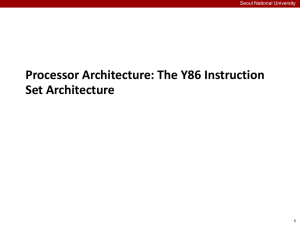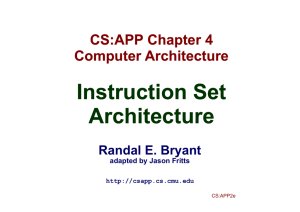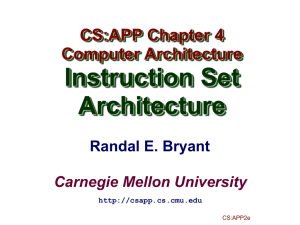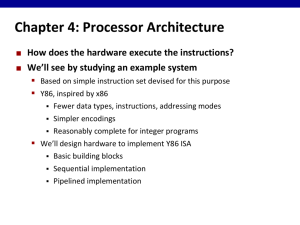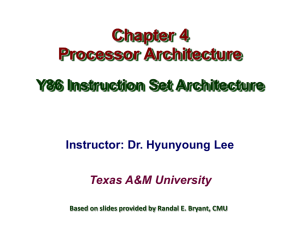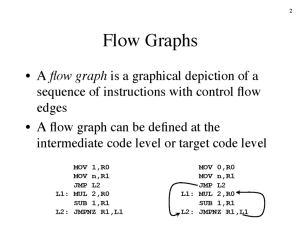LEC16 - Introduction to Computer System
advertisement
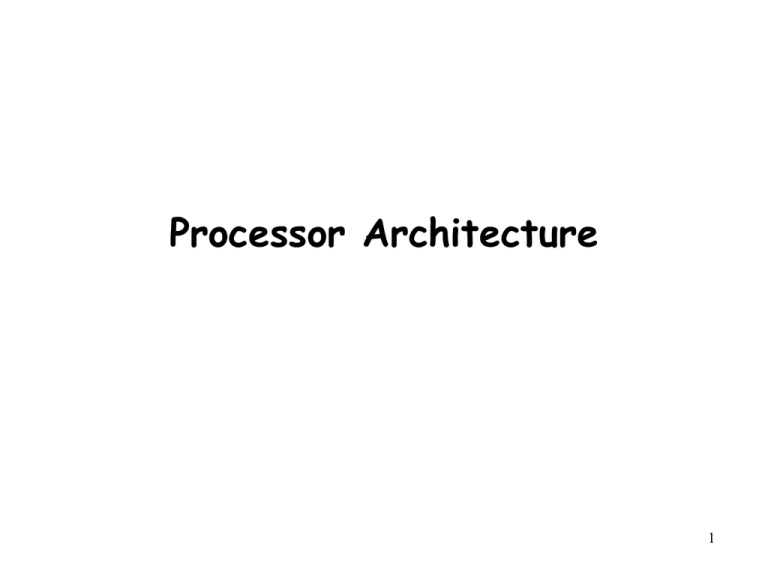
Processor Architecture 1 Coverage • Our Approach – Work through designs for particular instruction set • Y86---a simplified version of the Intel IA32 (a.k.a. x86). • If you know one, you more-or-less know them all – Work at “microarchitectural” level • Assemble basic hardware blocks into overall processor structure – Memories, functional units, etc. • Surround by control logic to make sure each instruction flows through properly – Use simple hardware description language to describe control logic • Can extend and modify • Test via simulation • Route to design using Verilog Hardware Description Language – See Web aside ARCH:VLOG 2 Goal • Understand basic computer organization – Instruction set architecture • Deeply explore the CPU working mechanism – How the instruction is executed • Help you programming – Fully understand how computer is organized and works will help you write more stable and efficient code 3 Today’s Topics • Y86 instruction set architecture • Suggested Reading: 3.4~3.7, 4.1 4 Instruction Set Architecture #1 • What is it ? – Assemble Language Abstraction – Machine Language Abstraction Instruction Set Architecture (ISA) • What does it provide? – An abstraction of the real computer, hide the details of implementation • The syntax of computer instructions • The semantics of instructions • The execution model • Programmer-visible computer status 5 Instruction Set Architecture #2 • Assembly Language View – Processor state • Registers, memory, … – Instructions • addl, movl, leal, … • How instructions are encoded as bytes Application Program Compiler OS ISA CPU Design • Layer of Abstraction (architecture) Circuit – Above: how to program machine Design (circuit) • Processor executes instructions in a sequence Chip – Below: what needs to be built Layout(device) • Use tricks to make it run fast • E.g., execute multiple instructions simultaneously 6 Instruction Set Architecture #3 • ISA define the processor family – Two main kind: RISC and CISC • RISC: SPARC, MIPS, PowerPC, ARM • CISC: X86 (or called IA32) • Under same ISA, there are many different processors – From different manufacturers • X86 from Intel, AMD and VIA – Different models (microarchitectures) • 8086, 80386, Pentium, Pentium 4 7 Y86 Processor State – Program Registers • Same 8 as with IA32. Each 32 bits – Condition Codes • Single-bit flags set by arithmetic or logical instructions – OF: Overflow ZF: Zero SF: Negative – Program Counter • Indicates address of instruction – Memory • Byte-addressable storage array • Words stored in little-endian byte order Program registers %eax %ecx %edx %ebx %esi %edi %esp %ebp Condition codes OF ZF SF PC Memory 8 Y86 Instruction Set #1 Byte 0 halt 0 0 nop 1 0 cmovXX rA, rB 2 fn rA rB irmovl V, rB 3 0 F rB V rmmovl rA, D(rB) 4 0 rA rB D mrmovl D(rB), rA 5 0 rA rB D OPl rA, rB 6 fn rA rB jXX Dest 7 fn Dest call Dest 8 0 Dest ret 9 0 pushl rA A 0 rA F popl rA B 0 rA F 1 2 3 4 5 9 Y86 Instructions • Format (P338) – 1--6 bytes of information read from memory • Can determine instruction length from first byte • Not as many instruction types, and simpler encoding than with IA32 – Each accesses and modifies some part(s) of the program state 10 Y86 Instruction Set #2 Byte 0 halt 0 0 nop 1 0 cmovXX rA, rB irmovl V, rB 2 3 1 2 3 4 fn rA rB 0 F rB V rmmovl rA, D(rB) 4 0 rA rB D mrmovl D(rB), rA 5 0 rA rB D OPl rA, rB 6 fn rA rB jXX Dest 7 fn Dest call Dest 8 0 Dest ret 9 0 pushl rA A 0 rA F popl rA B 0 rA F rrmovl 2 0 cmovle 2 1 cmovl 2 2 cmove 2 3 cmovne 2 4 cmovge 2 5 cmovg 2 6 5 11 Y86 Instruction Set #3 Byte 0 halt 0 0 addl 6 0 nop 1 0 subl 6 1 cmovXX rA, rB 2 fn rA rB andl 6 2 irmovl V, rB 3 0 F rB V xorl 6 3 rmmovl rA, D(rB) 4 0 rA rB D mrmovl D(rB), rA 5 0 rA rB D OPl rA, rB 6 fn rA rB jXX Dest 7 fn Dest call Dest 8 0 Dest ret 9 0 pushl rA A 0 rA F popl rA B 0 rA F 1 2 3 4 5 12 Y86 Instruction Set #4 Byte 0 halt 0 0 nop 1 0 cmovXX rA, rB 2 fn rA rB irmovl V, rB 3 0 F rB V rmmovl rA, D(rB) 4 0 rA rB D mrmovl D(rB), rA OPl rA, rB jXX Dest call Dest ret pushl rA popl rA 5 6 7 8 9 A B 1 0 2 3 rA rB 4 5 jmp 7 0 jle 7 1 jl 7 2 je 7 3 jne 7 4 jge 7 5 jg 7 6 D fn rA rB fn 0 Dest Dest 0 0 rA F 0 rA F 13 Encoding Registers • Each register has 4-bit ID %eax %ecx %edx %ebx 0 1 2 3 %esi %edi %esp %ebp 6 7 4 5 – Same encoding as in IA32, but IA32 using only 3-bit ID • Register ID 0xF indicates “no register” – Will use this in our hardware design in multiple places 14 Instruction Example • Addition Instruction Generic Form Encoded Representation addl rA, rB 6 0 rA rB –Add value in register rA to that in register rB • Store result in register rB • Note that Y86 only allows addition to be applied to register data –Set condition codes based on result –e.g., addl %eax,%esi Encoding: 60 06 –Two-byte encoding • First indicates instruction type • Second gives source and destination registers 15 Arithmetic and Logical Operations Function Code – Refer to generically as “OPl” 6 0 rA rB addl rA, rB – Encodings differ only by “function code” Subtract (rA from rB) • Low-order 4 bytes in Instruction Code Add subl rA, rB 6 1 rA rB And andl rA, rB first instruction word – Set condition codes as side effect 6 2 rA rB Exclusive-Or xorl rA, rB 6 3 rA rB 16 Move Operations rrmovl rA, rB 2 0 rA rB Register --> Register 3 0 F rB V Immediate --> Register rmmovl rA, D(rB) 4 0 rA rB D Register --> Memory 0 rA rB D Memory --> Register irmovl V, rB mrmovl D(rB), rA 5 – Like the IA32 movl instruction – Simpler format for memory addresses – Give different names to keep them distinct 17 Move Instruction Examples IA32 Y86 Encoding movl $0xabcd, %edx irmovl $0xabcd, %edx 30 82 cd ab 00 00 movl %esp, %ebx rrmovl %esp, %ebx 20 43 movl -12(%ebp),%ecx mrmovl -12(%ebp),%ecx 50 15 f4 ff ff ff movl %esi,0x41c(%esp) rmmovl %esi,0x41c(%esp) 40 64 1c 04 00 00 movl $0xabcd, (%eax) — movl %eax, 12(%eax,%edx) — movl (%ebp,%eax,4),%ecx — 18 Conditional Move Instructions Move Unconditionally rrmovl rA, rB 2 0 rA rB Move When Less or Equal cmovle rA, rB 2 1 rA rB Move When Less cmovl rA, rB 2 2 rA rB Move When Equal cmove rA, rB 2 3 rA rB Move When Not Equal cmovne rA, rB 2 4 rA rB Move When Greater or Equal cmovge rA, rB 2 5 rA rB Move When Greater cmovg rA, rB 2 6 rA rB – Refer to generically as “cmovXX” – Encodings differ only by “function code” – Based on values of condition codes – Variants of rrmovl instruction • (Conditionally) copy value from source to destination register 19 Jump Instructions Jump Unconditionally jmp Dest 7 0 Dest Jump When Less or Equal jle Dest 7 1 Dest Jump When Less jl Dest 7 2 Dest Jump When Equal je Dest 7 3 Dest Jump When Not Equal jne Dest 7 4 Dest Jump When Greater or Equal jge Dest 7 5 Dest Jump When Greater jg Dest 7 6 Dest – Refer to generically as “jXX” – Encodings differ only by “function code” – Based on values of condition codes – Same as IA32 counterparts – Encode full destination address • Unlike PC-relative addressing seen in IA32 20 Y86 Program Stack Stack “Bottom” • Increasing Addresses • Address of top stack element • – Stack grows toward lower addresses • %esp Stack “Top” – Region of memory holding program data – Used in Y86 (and IA32) for supporting procedure calls – Stack top indicated by %esp • Top element is at highest address in the stack • When pushing, must first decrement stack pointer • After popping, increment21stack pointer Stack Operations pushl rA A 0 rA F – Decrement %esp by 4 – Store word from rA to memory at %esp – Like IA32 popl rA – – – – B 0 rA F Read word from memory at %esp Save in rA Increment %esp by 4 Like IA32 22 Subroutine Call and Return call Dest 8 0 Dest – Push address of next instruction onto stack – Start executing instructions at Dest – Like IA32 ret 9 0 – Pop value from stack – Use as address for next instruction – Like IA32 23 Miscellaneous Instructions nop 1 0 – Don’t do anything halt 0 0 – Stop executing instructions – IA32 has comparable instruction, but can’t execute it in user mode – We will use it to stop the simulator – Encoding ensures that program hitting memory initialized to zero will halt 24 Status Conditions Mnemonic Code AOK 1 Mnemonic Code HLT 2 Mnemonic Code ADR 3 Mnemonic Code INS 4 – Normal operation – Halt instruction encountered – Bad address (either instruction or data) encountered – Invalid instruction encountered • Desired Behavior – If AOK, keep going 25 – Otherwise, stop program execution CISC Instruction Sets – Complex Instruction Set Computer – Dominant style through mid-80’s • Stack-oriented instruction set – Use stack to pass arguments, save program counter – Explicit push and pop instructions • Arithmetic instructions can access memory – addl %eax, 12(%ebx,%ecx,4) • requires memory read and write • Complex address calculation • Condition codes – Set as side effect of arithmetic and logical instructions • Philosophy – Add instructions to perform “typical” programming tasks 26 RISC Instruction Sets – Reduced Instruction Set Computer – Internal project at IBM, later popularized by Hennessy (Stanford) and Patterson (Berkeley) • Fewer, simpler instructions – Might take more to get given task done – Can execute them with small and fast hardware • Register-oriented instruction set – Many more (typically 32) registers – Use for arguments, return pointer, temporaries • Only load and store instructions can access memory – Similar to Y86 mrmovl and rmmovl • No Condition codes – Test instructions return 0/1 in register 27 MIPS Registers $0 $0 $1 $at $2 $v0 $3 $v1 $4 $a0 $5 $a1 $6 $a2 $7 Constant 0 Reserved Temp. $16 $s0 $17 $s1 $18 $s2 $19 $s3 $20 $s4 $21 $s5 $22 $s6 $a3 $23 $s7 $8 $t0 $24 $t8 $9 $t1 $25 $t9 $10 $t2 $26 $k0 $11 $t3 $27 $k1 $12 $t4 $28 $gp $13 $t5 $29 $sp $14 $t6 $30 $s8 $15 $t7 $31 $ra Return Values Procedure arguments Caller Save Temporaries: May be overwritten by called procedures Callee Save Temporaries: May not be overwritten by called procedures Caller Save Temp Reserved for Operating Sys Global Pointer Stack Pointer Callee Save Temp Return Address 28 MIPS Instruction Examples R-R Op Ra addu $3,$2,$1 R-I Op Ra addu $3,$2, 3145 sll $3,$2,2 Branch Op Ra beq $3,$2,dest Load/Store Op Ra Rb Rd 00000 Fn # Register add: $3 = $2+$1 Rb Immediate # Immediate add: $3 = $2+3145 # Shift left: $3 = $2 << 2 Rb Offset # Branch when $3 = $2 Rb Offset lw $3,16($2) # Load Word: $3 = M [$2+16] sw $3,16($2) # Store Word: M [$2+16] = $3 29 CISC vs. RISC • Original Debate – Strong opinions! – CISC proponents---easy for compiler, fewer code bytes – RISC proponents---better for optimizing compilers, can make run fast with simple chip design • Current Status – For desktop processors, choice of ISA not a technical issue • With enough hardware, can make anything run fast • Code compatibility more important – For embedded processors, RISC makes sense • Smaller, cheaper, less power • Most cell phones use ARM processor 30 Summary • Y86 Instruction Set Architecture – Similar state and instructions as IA32 – Simpler encodings – Somewhere between CISC and RISC • How Important is ISA Design? – Less now than before • With enough hardware, can make almost anything go fast – Intel has evolved from IA32 to x86-64 • Uses 64-bit words (including addresses) • Adopted some features found in RISC – More registers (16) – Less reliance on stack 31 Next • Logic design • Hardware Control Language HCL • Suggested Reading: 4.1, 4.2 32
